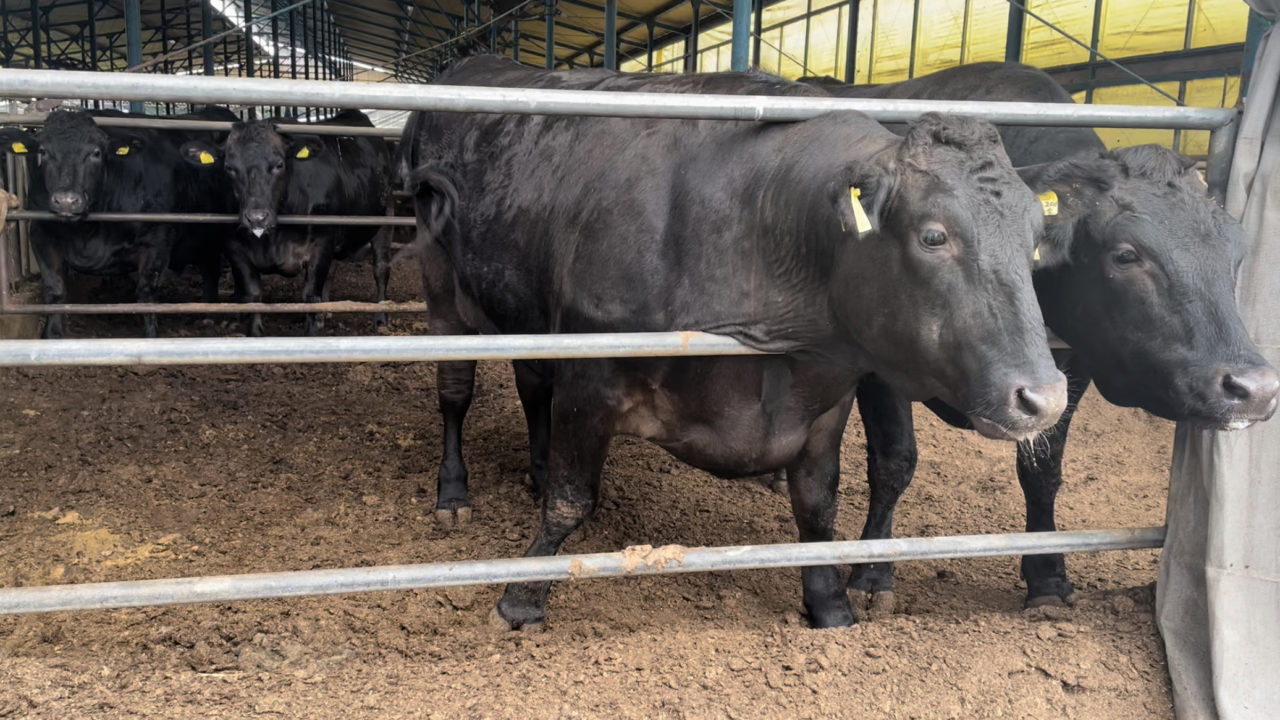After he inherited a farm from his father-in-law in Japan 40 years ago, Hiroo Takeuchi was milking 50 cows.
Today, the farmer runs a highly-intensive mixed enterprise, called ‘Wealthy Farm’, with 900 Wagyu cattle and 1,000 Holstein Friesian cows on two farms across 40ha, and he has plans to expand further.
Located in Tochigi, north of Tokyo, it is part of a group of so-called ‘mega-farms’ in the region serving the strong demand for liquid milk from the capital city.
The dairy and beef animals on both farms are housed year-round in sheds with fans to keep them cool in warmer months.
As part of a recent visit to the farm with Bord Bia, Agriland also joined the farmer as he sold stock in a local mart specialising in the famous Wagyu breed.
You can check out the farm and mart by clicking on the video below:
Wagyu beef production focuses on weight, confirmation and, most importantly, the marbling in the meat.
Cattle are finished at 30 months and weigh around 850kg at slaughter. In some instances, the animals can tip the scales at 1t.
Takeuchi reported a kill rate of 68% and has set himself a target of at least 550kg dead weight.
Depending on quality, farmers will get a carcass price of €20-30/kg.
Takeuchi noted that cull cows can achieve similar prices to younger steers.
The farmer also buys and sells the cattle at 20 months when they weigh around 550-600kg.

There are three workers on his Wagyu fattening farm, where the animals are kept in pens lined with sawdust that is mixed with manure which ferments and sterilises the bedding.
The animals are intensively fed a mixture of hay and concentrate. The farm is 25% self-sufficient for feed through growing maize, the remaining demand is met by importing soya bean, corn, hay and alfalfa from the US and Australia.
The average cost of Wagyu beef production is announced each month for every prefecture or district in the country.
If the market price is below cost of production, the Japanese government subsidises farmers to cover up to 80% of the difference.

There are no bulls on Takeuchi’s farms, the beef and dairy breeding is done through artificial insemination (AI).
Takeuchi was among the first farmers in Japan to use embryo transfer in his dairy herd as a means of boosting his Wagyu cattle numbers.
It is a system that is now commonly seen in Wagyu production in Japan to ensure a steady flow of progeny for producers.

The farmer has 300 breeding Wagyu for calf and embryo production; 180 rear their own calves, while 120 are used for embryos.
Every Saturday, an AI technician calls to the farm and flushes up to four cows. Embryo collection starts around two years of age and can continue until the cow is 10 years old, if the genetics are desirable.
Wagyu cows rearing their own calves may continue breeding until 15 years of age.
Calves are weak and susceptible to cold weather when they are born so require careful management and are kept together in a pen for up to two months.
Bull calves are castrated at one-month-old, using rubber rings.

Of the 80 calves born every month in the dairy herd, 30 are purebred Wagyu and there are around 25 dairy heifers for replacements.
The remaining 25 are ‘F1’ Holstein/Wagyu crossbred calves, which are sold at one month in the mart. The price for such calves has halved to €700/hd this year due to increased feed costs.
40 workers are employed in the dairy operation where the Holstein Friesian cows are milked three times a day.
Milk price in Japan is traditionally set once a year following negotiations between farmer cooperatives and the dairy producer association and is based on an average-sized farm of 50-60 cows.
However, due to the sharp increase in feed costs, the price is being increased by 10 yen/L.
Takeuchi, who currently gets a net milk price of 105 yen/L (0.73c/L), said that the increase is not enough to cover the jump in costs.
A trip to the mart
Agriland also joined the farmer as he brought a group of 10-month-old Wagyu weanlings to sell at a nearby mart.
The mart, which exclusively trades in the breed, hosts weanling sales twice per month.
All vehicles entering the mart yard were sprayed with disinfectant as part of a strict disease-control measures.

On the day Agriland visited, there were hundreds of animals being offered for sale with a brisk trade taking place.
Once unloaded from the cattle lorries, the weanlings, weighing around 300kg, are put into pens.
A halter and individual identification tag is then placed on each of the animals which are lined up according to their sales number.

The bullocks and heifers were washed and groomed by the sellers before being sold individually.
The weanlings entered into the sales ring on a pully system with a moving chain where their breeding is displayed on an electronic board.
Once sold, the weanlings are taken to the loading area for transport.
Expansion
Hiroo Takeuchi is currently in expansion mode, developing a second dairy farm with a rotary parlour, along with buying more land to expand his Wagyu fattening enterprise.
The Japanese government is currently discussing sustainability measures but no regulations have yet been placed on farmers.
Slurry from Wealthy Farm is currently distributed to neighbouring holdings for free or at a nominal price.
